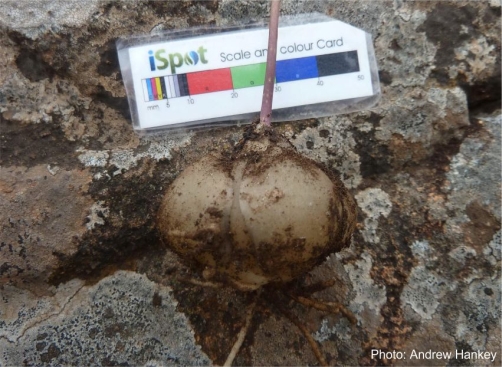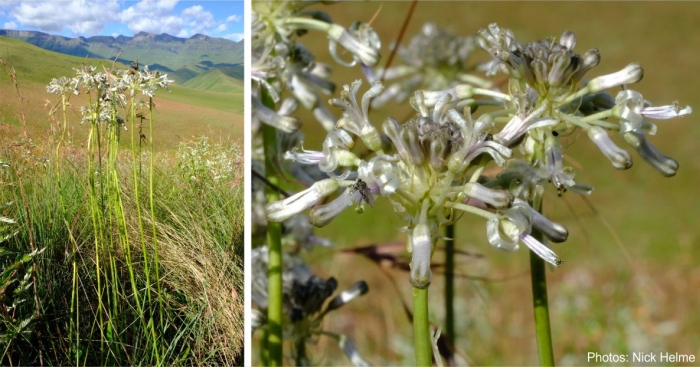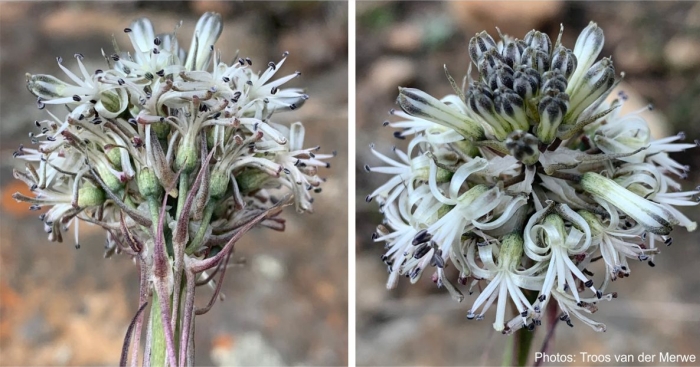Drimia sphaerocephala
Drimia sphaerocephala Baker
Family: Hyacinthaceae
Common names: round-head drimia (Eng.); snotuintjie (Afr.); hlare-sa-noko (Sesotho).
Introduction
The phrase “simplicity is the ultimate sophistication” is well expressed by the plant Drimia sphaerocephala. A bulbous plant wearing a rounded, white head of compact flowers, with nectar to feed and to thank the laborious insects for pollination. The plant being so simple and naïve, unarmed, with zero thorns and welcoming, having a green medium-sized stalk of less than 1.5 m tall and an inflorescence consisting of 15 to 30 flowers. The flowers lack the ability to be distinguished between separate petals and sepals forming what is known as tepals. The leaves are hysteranthous, meaning that they appear after the plant has flowered, and they have conspicuous hairs on the edges. This beautiful plant chose its nature’s address in the marshy slopes and moist areas of Lesotho, Eastern Cape, Eswatini extending as far as Musina in the Limpopo Province.

Description
Description
A medium sized, deciduous bulbous plant, about 500 mm tall, with a white to pinkish bulb measuring 20-40 mm in diameter. The bulb has closely packed scales. Leaves are very few, 2-4, with long hairs on the margins, emerging from the ground and growing towards the inflorescence once the flowers have opened and matured. Inflorescence ranging from 300 to 450 mm in length, a roundish raceme, consisting of 15 to 30 flowers. Flowers white, with fused petals and sepals known as tepals, closely packed to each other and having both the bracts and nectar spur, joined to the inflorescence by pedicels. Older flowers are found at the bottom of the inflorescence and newly flowers at the top of inflorescence. The flowers have a short-life span of 3 days at most, visible around midsummer, from November to early January, giving rise to a fruit that is a capsule which produces elliptical seeds.

Conservation Status
Status
According to the Red List of South African plants, Drimia sphaerocephala is assessed as Least Concern (LC).
Distribution and habitat
Distribution description
Drimia sphaerocephala is found in moist areas or marshy slopes in South Africa, Lesotho and Eswatini. Its distribution ranges from the Eastern Cape to KwaZulu-Natal, Lesotho and the Free State, heading northwards to Mpumalanga, Eswatini and as far as the Limpopo Province.

Derivation of name and historical aspects
History
The name Drimia is derived from the Greek word drymis, which means ‘acrid or bitter’, referring to the taste of the bulb or root of some species within this group. The name sphaerocephala means ‘a round head’, given to the species due to its compact floral arrangement in the shape of ball or sphere.
The genus Drimia has a worldwide distribution, with over 110 species recorded in Africa, Asia, Madagascar and the Mediterranean region (Manning & Goldblatt 2018). In the southern African region, the genus accounts to 70 species, with 61 species strictly limited to this region. Taxonomic treatment of Drimia or rather the classification of the genus has always been problematic, however, in 2018, Manning and Goldblatt revised the southern African species and categorized them into 20 sections. There are several prominent species within the group such as Drimia elata, D. indica, D. maritima and D. wightii. In South Africa, Drimia elata is used by the Zulu people as pain reliever (Hutchings et al. 1996; Ndhlala et al. 2013), by the Bapedi to treat sexually transmitted diseases (Semenya et. al. 2013) and used in small doses by the natives of Ga-Mashashane area in Limpopo Province as blood purifier (Papo 2017). Drimia indica and D. wightii are used in India to treat cardiac problems as these species contain cardiac glycosides, however, dosage and knowledge on the use of these plants is very vital as some species are lethal and toxic (Sharma and Devi 2017). Drimia sphaerocephala closely resembles D. elata, they differ in the lower flowers which seem laxly spaced in D. elata and the bracts of D. sphaerocephala are spurred.

Ecology
Ecology
The flowers of Drimia sphaerocephala are short-lived, having a lifespan of 3 days at most. There is little information on the specific pollinators, however, like most other Drimia species, these plants could be pollinated by insects such as bees, butterflies and moths.

Uses
Use
Drimia sphaerocephala is used to treat external tumours and is believed to frighten thokolosi, and this plant makes the skin itch if touched (Moffett 2010).

Growing Drimia sphaerocephala
Grow
Little is known on the propagation of Drimia sphaerocephala and the assumption is made that it can be propagated by the same methods as those for Drimia filifolia. Propagate from seed. Sow the seed during the growing season, in spring (September-October) in a very well-drained (sandy) medium. Disperse the seed on the top layer of the sowing medium and cover them with a light layer of sand. Try not to over-water or let the seeds dry out. Water them more than once, week after week. Germination is moderately quick, requiring roughly a month. When the seedlings have developed, plant them out into reasonably sized pots. Plant them in a well-drained medium comprised of a combination of sand, loam and compost. The seedlings ought to require a half year to reach maturity. During seedling development, it could be important to repot them into bigger pots. Water them once or twice weekly.
Best in summer-rainfall gardens, plant them in a sunny, well-drained but well-watered position or keep them in a container. Suggested companion plants include moisture-loving plants such as Kniphofia spp., Chorophytum spp., Crinum bulbispermum and Hesperantha coccinea.
References
- Bushell, G. 2021. Observation of Drimia sphaerocephala, Galway Amajuba, KZN. https://www.inaturalist.org/observations/102432024.
- Deacon, J. 2014. Drimia filifolia (Jacq.) J.C.Manning & Goldblatt (Hyacinthaceae). PlantzAfrica. http://pza.sanbi.org/drimia-filifolia.
- Hankey, A. 2013. Observation of Drimia sphaerocephala, Makobulaan Nature Reserve, Mpumalanga. https://www.inaturalist.org/observations/10879828.
- Helme, N. 2021. Observation of Drimia sphaerocephala, Giant’s Castle Nature Reserve, KZN. https://www.inaturalist.org/observations/105217954.
- Hutchings, A., Scott, A.H., Lewis, G. & Cunningham, A.B. 1996. Zulu medicinal plants: an inventory. University of Natal Press, Pietermaritzburg.
- Manning, J.C. & Goldblatt, P. 2018. Systematics of Drimia Jacq.(Hyacinthaceae: Urgineoideae) in Southern Africa. Strelitzia 40. South African National Biodiversity Institute, Pretoria.
- Moffett, R. 2010. Sesotho plant and animal names and plants used by the Basotho. Sun Press, Bloemfontein.
- Ndhlala, A.R., Finnie, J.F. & Van Staden, J. 2011. Plant composition, pharmacological properties and mutagenic evaluation of a commercial Zulu herbal mixture: Imbiza ephuzwayo. Journal of Ethnopharmacology 133, 663–674.
- Papo, L.A. 2017. The ethnobotanical, antimicrobial and phytochemical screening of selected medicinal plants from Ga-Mashashane, Limpopo, South Africa. M.Sc. Dissertation, University of Johannesburg, Johannesburg.
- Pooley, E. 1998. A field guide to wild flowers Kwazulu-Natal and the eastern region. Natal Flora Publications Trust, Durban.
- Raimondo, D., Von Staden, L., Foden, W., Victor, J.E., Helme, N.A., Turner, R.C., Kamundi, D.A. & Manyama, P.A. (eds) 2009. Red list of South African plants. Strelitzia 25. South African National Biodiversity Institute, Pretoria.
- Semenya, S. et al. 2013. Herbal medicines used by Bapedi traditional healers to treat reproductive ailments in the Limpopo Province, South Africa. African Journal of Traditional, Complementary Alternative Medicines 10(2): 331–339
- Sharma H.J. & Devi N.S. 2017. Phytochemical Analysis of Drimia Species. Int J Appl Sci Res Rev. Vol. 4 No. 2:12.
- Van Der Merwe, T. 2020. Observation of Drimia sphaerocephala, R37, Mpumalanga. https://www.inaturalist.org/observations/65619775.
- Whatmore, J. 2020. Observation of Drimia sphaerocephala, Ehlanzeni, Mpumalanga. https://www.inaturalist.org/observations/66179763.
Credits
Lesiba Papo
National Herbarium, Pretoria
July 2022
Acknowledgements: the author thanks Nick Helme (aka Botaneek), Jimmy Whatmore (aka jimmy_finsbury), Andrew Hankey, Garth Bushell and Troos van der Merwe for making their images available via iNaturalist.
Plant Attributes:
Plant Type: Bulb
SA Distribution: Eastern Cape, Free State, KwaZulu-Natal, Limpopo, Mpumalanga
Soil type: Sandy, Loam
Flowering season: Early Summer, Late Summer
PH:
Flower colour: White
Aspect: Full Sun
Gardening skill: Average
Special Features:
Horticultural zones








Rate this article
Article well written and informative
Rate this plant
Is this an interesting plant?
Login to add your Comment
Back to topNot registered yet? Click here to register.